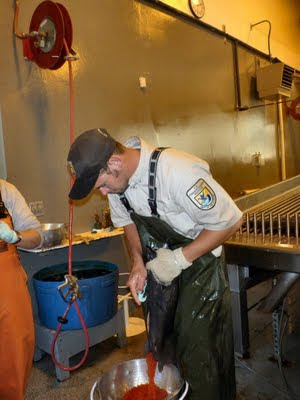
This is the time of year that we begin to spawn the Chinook salmon that are returning to our hatcheries. Hatchery staff do the actual spawning but people from our office are responsible for biosampling the fish. After the fish are spawned and sampled by the fish health people to test for disease, the fish are handed over to us.

Bio-sampling consists of recording the sex and fork length of the salmon. A couple of scales from each side of the fish are removed and placed on scale cards so we can determine the age of the fish later. We also collect the snouts of any fish with coded wire tags. How do we know if a fish has a coded wire tag? In years past, a fish with no adipose fin was tagged. Not so anymore. Most or all fish from hatcheries are now marked with an adipose clip regardless of whether it is tagged. So before heading to our table they all pass through a tag detector which separates the tagged fish from untagged fish.

What is this information used for? Aged scale data, coded wire tag recoveries, and other data collected during sampling is used to evaluate annual hatchery returns and compile annual run age compositions. Data is also used to help predict preseason run size for the upcoming year.
Visitors are welcome to view the spawning operation at our national fish hatcheries. Visit the Gorge hatcheries website for schedules and contact information or our salmon webcam to see the salmon returning to Little White Salmon NFH.
Submitted by Pat Kemper, Steve Lazzini, and Donna Allard
No comments:
Post a Comment